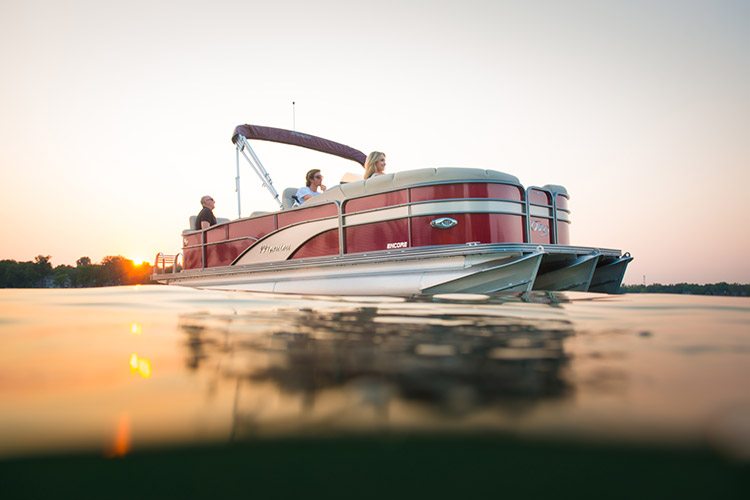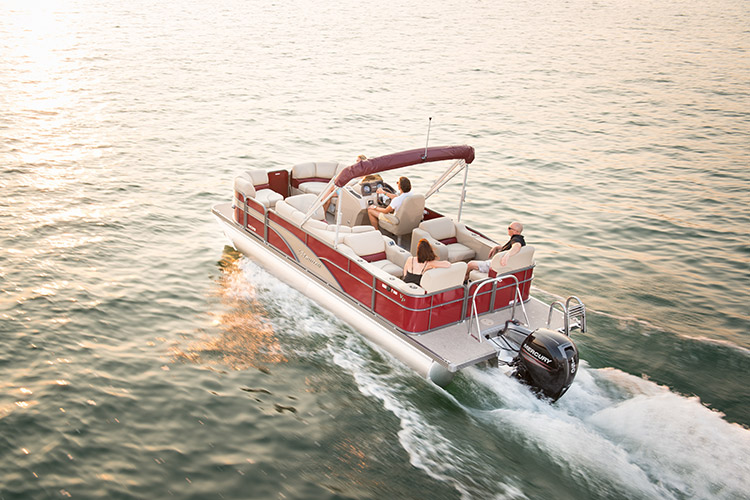Advertisement
Advertisement
Manitou 23 Encore SR VP: Relaxation Nation
Lay back and unwind; Manitou’s brewed up one of the comfiest pontoon boats on the market, with the 2016 23 Encore.
December 14, 2015
Comfort and relaxation—they’re two things you expect from a pontoon boat. But when it comes to those two attributes not all pontoon boats make the grade. Whether it’s weird deck layouts or subpar upholstery, well, some pontoons simply fall short.
One pontoon boat I ran in this summer at Petoskey, MI, on Little Traverse Bay most certainly did not fall short: the Manitou 23 Encore SR VP. It had not only a deck and seating layout with lots of ingenuity, but also some of the nicest furniture and upholstery I’ve seen on any pontoon boat—regardless of price.
Lansing, MI, is where Manitou pontoons are built, and the company produces boats ranging from 18 to 27 feet encompassing nine model lines with more than 36 different models and countless floor plans. Phew! The Encore line sits in the middle of those ranges, starting out around $35,000. My review version priced out to just above $50,000. It included some hefty options such as the Yamaha VMAX SHO 115 outboard, faux teak decking, and an upgraded seating package.
Build quality on all Manitou boats is top-notch and the manufacturer places an emphasis on quality welding, rigid deck support structures, and employing modern technology. As with all Manitou pontoons, my 23 Encore test craft came with a limited lifetime warranty on the decking and structural components, while furniture vinyl, Bimini fabrics, carpet and mooring covers are covered for five years. Let’s step aboard, shall we?
The quality and feel of the furniture and upholstery used in the 23 Encore’s layout are worth noting. The high pillowtop seats are extraordinarily cushy, and the texture of the vinyl is difficult to discern from that of real leather. Blue accent “cool-touch” fabric is used on lower back areas, and the seat bottom cushions are plush and soft, yet very supportive. I had a tough time finding flaws in any of the upholstery work, and could tell a lot of care went into its assembly.

Be warned: lay back in one of the Encore’s lounges and you’ll have a difficult time convincing yourself to get back up.
Getting into the nitty-gritty of the deck layout reveals a lot of ingenuity. Up forward to starboard is an L-shaped lounge that can be used as a forward-facing chaise, or as a seating area for two or three people. To port across from it is a small, one-person bench. But add in an optional filler seat that snuggles between the two areas and you have a huge U-shaped lounge that fills up the forward end of the deck entirely. That optional filler seat can also be moved around as a standalone chair anywhere it’s needed; it’s a nice way to add modularity to the seating scheme.
Moving farther aft I found a cozy two-person lounge to port with a U-shaped seatback that creates an intimate area for two. It’s also nicely situated across from the helm to facilitate conversations with the skipper while underway. The helm itself is nicely appointed but fairly basic. My test craft had straightforward analog gauges along with a digital fuel meter display. The Manitou rep who accompanied me on my ride told me that a number of digital performance displays are available, and that’s the route I’d take I were ordering one of these for myself. I’m a gear-head who’s always looking to see what my systems are up to.
All the way aft is where I stumbled upon some real cleverness. Back here are two “booths” that are shaped much like those you’d find in a restaurant, replete with a pedestal table that slides into a base. The clever bit is that one of each set of two seats is convertible. Simply remove the table, flip down the aft seatback, and it angles down to form an aft-facing chaise lounge. Another nice touch: the seat bases are made entirely of molded fiberglass. Many pontoon makers use rotomolded PVC, which is less durable in the long run.
Under the deck, Manitou offers two different performance tube packages: the Sport Handling Package (SHP), and the VP system. The VP system, as you may have guessed by “VP” in the 23 Encore SR VP’s name, is the one my test boat was fitted with. It’s based on Manitou’s patented V-Toon technology, which utilizes larger, lowered center tubes, lifting strakes, side keels, and wave-piercing nosecones. The package delivers exceptional performance and cornering characteristics you wouldn’t expect from a pontoon boat.
On the back of my test craft was Yamaha’s VMAX SHO 115 four-stroke outboard, introduced just last year at the company’s Alabama test facility. Designed to offer some of the traditional characteristics of a two-stroke engine, such as impressive low-end grunt, the small four-cylinder outboard looked like a good match for the Encore 23 SR VP. I took it out on Little Traverse Bay to give it a whirl.
One of the qualities I’ve come to love about this engine is how incredibly quiet and vibration-free it is. Indeed, I found it difficult to hear it working away on the stern as we motored out of the harbor at Petoskey, MI. In fact, it’s smooth and quiet even when you open it up to stretch its legs a bit. It may not seem like a big deal, but vibration and noise can definitely add to the fatigue-factor during a long day out on the water. I appreciated the lack of both with this engine.
Laying the hammer down delivered an impressive hole shot, with the Yamama VMAX SHO 115 taking just under seven seconds to get the 23 Encore up to 20 MPH. Sure, that isn’t neck-snapping acceleration, but it’s definitely impressive for a 115-horsepower engine pushing nearly 3,000 pounds of pontoon. Midrange performance is quick and snappy, too, and I noted almost instantaneous throttle response when I hit it between 3,500 and 4,000 RPM. Continuing to accelerate up to 5,900 RPM, I saw a top-end of 29.2 MPH.
When it came time to spin the Encore 23 in circles and tight turns, I found that the VP pontoon package delivered impressive cornering. There was no wallowing, and the boat leaned into the turns nicely, feeling as if it was on rails when really pressed hard. Additionally, the whole package felt rugged and stable as we blasted across a one- to two-foot chop.
I only found a couple of downsides worth noting. If you opt for the watersports tow bar on the stern you might find that it cramps things up a bit back there—I wish they’d mounted it a little farther aft. Also, some of the doors and access hatches rattled a bit underway, which could be easily remedied by adding some foam or rubber furniture bumpers. Otherwise, there wasn’t much to complain about.
I had a great time running the Manitou 23 Encore SR VP. If you’re browsing around for a midrange pontoon boat with great performance and tons of relaxation and comfort baked in, this one’s definitely worth a closer look.
Other Choices: Some competing pontoon boats running the same waters include the Cypress Cay Cabana 220, and the Bennington 2250 GSR (also tested by boats.com with the Yamaha 150 VMAX SHO).
For more information, visit Manitou.
See Manitou 23 Encore listings.
| Performance Data | |||
|---|---|---|---|
| Test conditions: one-foot seas, winds 5-10 mph, 2 POB. | |||
| RPM | MPH | GPH | MPG |
| 1000 | 4.1 | 0.5 | 8.20 |
| 2000 | 7.0 | 1.1 | 6.36 |
| 3000 | 11.4 | 2.5 | 4.56 |
| 4000 | 18.4 | 4.4 | 4.18 |
| 5000 | 24.2 | 7.6 | 3.18 |
| 5900 | 29.2 | 11.4 | 2.56 |
| Power | Single Yamaha F115 V MAX SHO four-stroke outboard, swinging a 14 X 13 stainless-steel prop. | ||
| Specifications | |
|---|---|
| Length | 24’4” |
| Beam | 8’6” |
| Draft (hull) | N/A |
| Displacement | 2,510 lbs |
| Fuel capacity | 44 gal. |
| Water capacity | N/A |
Advertisement
Related Boats for Sale
See more boats like thisAdvertisement



















